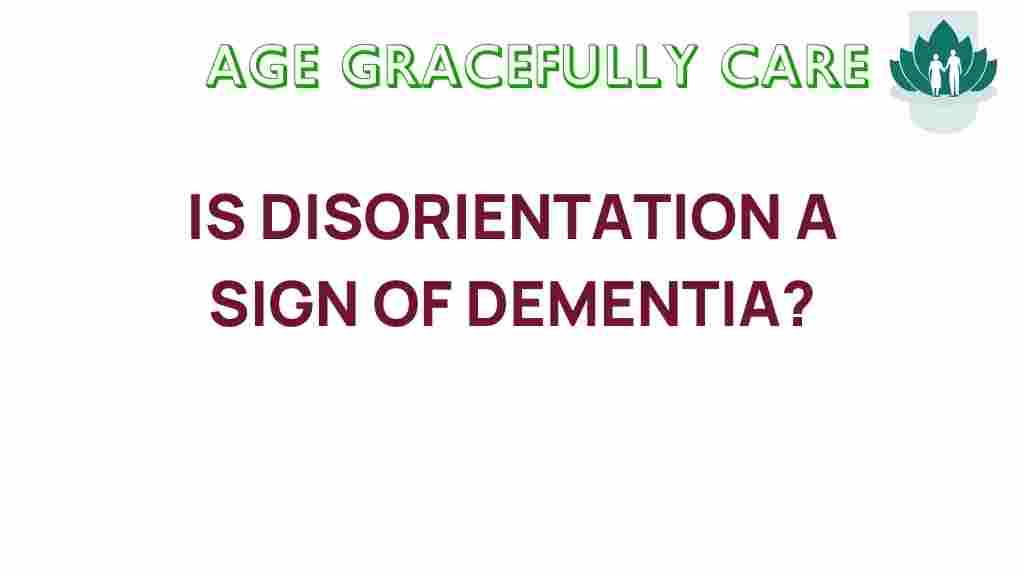Is Disorientation a Hidden Indicator of Dementia’s Onset?
As our loved ones age, it’s natural to notice changes in their behavior and cognitive abilities. One of the most concerning signs that can emerge is disorientation. Many people might dismiss disorientation as a normal part of aging; however, it can be a hidden indicator of dementia’s onset. In this article, we will explore the connection between disorientation and dementia, the implications for cognitive decline, and how to raise awareness about these early signs.
Understanding Disorientation
Disorientation refers to a state of confusion regarding time, place, or people. It’s not uncommon for older adults to occasionally forget where they are or what day it is, but frequent episodes can be a cause for concern. It is crucial to differentiate between normal age-related changes and potential symptoms of more serious conditions, such as dementia.
Disorientation and Dementia: The Connection
Dementia is a general term that describes a decline in cognitive function severe enough to interfere with daily life. Disorientation can be an early sign of this decline. People with dementia may experience:
- Confusion about the time of day or the current date.
- Difficulty recognizing familiar places or people.
- Inability to follow conversations or remember recent events.
These symptoms often stem from neurological changes in the brain associated with dementia. As these changes progress, individuals may experience increasing levels of disorientation, ultimately impacting their overall mental health.
Early Signs of Dementia: Recognizing the Symptoms
Understanding the early signs of dementia, including disorientation, is critical for timely intervention. Here are some common symptoms that may accompany disorientation:
- Memory Loss: Frequent forgetfulness about recent events, appointments, or conversations.
- Difficulty with Problem-Solving: Struggling to follow familiar recipes or manage finances.
- Changes in Mood or Personality: Sudden shifts in emotions or withdrawal from social activities.
- Reduced Ability to Focus: Difficulty concentrating or keeping track of multiple tasks.
Recognizing these symptoms early can lead to more effective management of the condition and better support for those affected.
The Role of Aging in Cognitive Decline
Aging is often accompanied by various cognitive changes. While some degree of cognitive decline is expected, significant changes may indicate a more serious issue. Disorientation is one of the early warning signs that should not be overlooked. Factors that contribute to cognitive decline in aging include:
- Genetics: Family history of dementia can increase risk.
- Health Conditions: Conditions like diabetes and hypertension may contribute to cognitive issues.
- Lifestyle Choices: Poor diet, physical inactivity, and social isolation can exacerbate cognitive decline.
Maintaining neurological health through a balanced lifestyle can help mitigate these risks.
Assessing Disorientation: When to Seek Help
If you notice disorientation in yourself or a loved one, it’s essential to assess the situation carefully. Here’s a step-by-step process to help you determine when to seek professional help:
Step 1: Observe the Frequency and Context
Take note of how often disorientation occurs and in what contexts. Is it during stressful situations, or does it happen randomly? Tracking these patterns can provide valuable insight.
Step 2: Evaluate Other Symptoms
Look for accompanying signs of cognitive decline, such as memory loss or changes in personality. The presence of multiple symptoms can indicate a more serious issue.
Step 3: Communicate Concerns
If you’re worried about a loved one, approach them with empathy. Discuss your observations without placing blame. Open communication can help them feel supported.
Step 4: Consult a Healthcare Professional
It’s important to consult a healthcare professional if disorientation and other symptoms persist. They can conduct cognitive assessments and provide guidance on next steps.
Troubleshooting Tips for Managing Disorientation
While waiting for a professional evaluation, there are several strategies you can employ to help manage disorientation:
- Establish Routines: Consistent daily routines can help create a sense of stability and familiarity.
- Use Memory Aids: Encourage the use of calendars, reminders, and notes to help with memory retention.
- Enhance the Environment: Create a calm and organized living space to reduce confusion and anxiety.
- Encourage Social Interaction: Engage in social activities to stimulate cognitive function and improve mood.
These tips can help alleviate some of the confusion associated with disorientation while promoting overall mental health.
Raising Awareness About Dementia and Disorientation
Increasing awareness about the signs of dementia, especially disorientation, is crucial for early intervention. Here are some ways to promote awareness:
- Educate Yourself: Understanding dementia and its symptoms can help you recognize changes in yourself and others.
- Share Information: Talk to friends and family about the importance of recognizing early signs of cognitive decline.
- Support Organizations: Consider supporting or volunteering with organizations focused on dementia research and education. You can find more information here.
By fostering a community of awareness, we can better support those affected by dementia and improve their quality of life.
Conclusion
Disorientation can indeed be a hidden indicator of dementia’s onset. Recognizing this early sign, along with other symptoms of cognitive decline, is essential for timely intervention. By understanding the connection between disorientation and dementia, we can take proactive steps to maintain neurological health and support aging loved ones.
Awareness is key. If you or someone you know is experiencing frequent disorientation, don’t hesitate to seek help. Together, we can navigate the challenges of aging and dementia, ensuring that our loved ones receive the care and support they deserve.
For more in-depth information about dementia and cognitive health, explore our other articles here.
This article is in the category Health and created by AgeGracefullyCare Team
